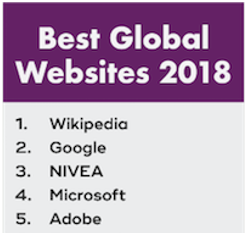Effective Global Content Strategy - It’s More Than Translation
 Today brands often make the mistake of thinking that they can develop one message and run with it – translated or not – in every single region. They think of this, as brand consistency or unifying the brand across markets. But in many situations, even global level brands may be perceived as something different in multiple markets, even though it may have a global awareness it may not have global understanding. A global content strategy will account for this.
Today brands often make the mistake of thinking that they can develop one message and run with it – translated or not – in every single region. They think of this, as brand consistency or unifying the brand across markets. But in many situations, even global level brands may be perceived as something different in multiple markets, even though it may have a global awareness it may not have global understanding. A global content strategy will account for this.
So What is a Global Content Strategy?
Defined by CEO of Content Rules and renowned content strategist Val Swisher: “A global content strategy is a structure for managing all of your content that is consumed by people in languages other than the source.”
Here are some interesting stats provided by LTI about global content that will help solidify the need for a Global Content Strategy in place.
- 75% of people say that they would be more likely buy the product if customer support was in their own language.
- More than 32 Million consumers in America speak another language other than English at home.
- Over have the consumers polled said access to product information in their own language is more important than price. Over 83% of small to midsize business in the United States List oversea expansion as a top priority.
- 95% of midsize companies plan to have international clients in the next 3 years
- 42% of internet users polled only purchase products and services in their native language.
- 90% of internet users said when given a choice, they always visit a website in their own language.
These are some staggering stats that should not be overlooked. Since global content localization can be such a grueling task, you really should take care of having a detailed global content strategy. If you are a global company, you will want to be accessible to all your customers in all parts of the world, and you will want to do it correctly! Here are a few reasons you should have a great strategy:
-
How much will you spend localizing and translating content, today we are all about dollars and cents and value for you money plays an important role.
-
Quality of your content in all languages, you don’t want misunderstanding or mis-representation.
-
How long will it take to localize and translate content? Remember time is money!
What Steps Should Be Taken to Create Global Content Strategy?
Global Content Audit: Probably the most important first step – assessing and understating the scope of your content that will be localized and translated. Who will store the information and who will create it?
Tracking content: Most CMS platforms today have a robust set of tools for tracking and managing content. Otherwise, whatever tool you decide to use, make sure it’s easy to use and accessible to your translation team; what’s been translated, record translation vendor and who is responsible for checking off the boxes.
Access your global audience: Understand who your audience is and where they live. Currently only 20% of all Internet users are native-English speakers. So how do you prioritize? The best place to start is to look at your competitors and your sales markets. Evaluate what your goals are and where you want your business to go. Understanding these will help your global content strategy goals.
Where All Versions of the Content Will Live: You may not think it’s a big deal but, you need to take a detailed look at the design of the sites you’ll use to manage your global content strategy. You should consider any technical differences that will alter how you create and publish content for a given audience. Take note of any site elements that will impact how your readers consume the content you create. Do you want to have a separate site and URL for each market or do you want to have a global gateway on your site? How will users navigate to a separate environment? Will it have a similar look and feel?
Selecting the Team: The next step is to decide who will execute this program for you. When considering this, keep these best practices in mind. First, it is highly recommended to use an outside vendor for the localization of content, such as SDL or LionBridge. By leveraging experts you are ensuring that your content will be localized properly, and they will be able to flag issues or bring up considerations you may not have thought of otherwise.
Translating the content: Since translating content can be expensive, the big question that arises is “What to translate and what not to translate?” You want to ensure that you are providing optimal return on your investment. Consider this – do you need to translate white papers and reports? If this is important you may want to look at the other option transcreation – essentially its a team made up of creative and localization experts that recreates the content for a specific market, and this option can be quite costly. For frequently published content such as social media feeds you may want to consider a more automated approach.
Things to consider when prepping your content for localization:
-
Keep text to minimum. Because translation costs are based on the number of words, keeping it short and concise will keep you within budget.
-
Keep text clear. If a native speaker has trouble understanding the source content, or could possibly interpret the text in more than one way, the translator and subsequent target audience will have a difficult time understanding.
-
Allow room for text expansion. Most languages are longer than English by 15%. Russian, for example, can be 40% longer.
-
Use consistent terminology. Using consistent phrases and regular brand vocabulary will help the source and localized versions to be more effective. This will also benefit your translators and speed up their process.
-
Remember SEO and keywords. Since it's so important don’t forget to integrate SEO translation into your content!
Cultural Relevancy: Unfortunately, there isn’t a one size fits all approach for this globally since every country is different. You need to consider your branding effort as well across the global markets. The key is to know your audience and understand which approach to take in which markets and target them correctly. When you are putting this much energy into your strategy don’t forget how the content will be delivered. At the same time, while it is important to support local-language social platforms, you still want to keep realistic expectations.
Ending Notes:
Today it’s not enough to just translate your English content. You have to customize the content to serve the needs of your intended audience, while being sensitive to cultural norms and linguistic quirks.
A survey by the Content Marketing Institute, revealed that 54 per cent of B2B and 50 per cent of B2C marketers find it a challenge to produce engaging content. And only 38 per cent of B2B and 37 per cent of B2C marketers consider their organization to be effective at global content marketing. So having an effective global content strategy is critical.
John Yunker of Byte Level Research has been producing a web globalization report card. In the report, he benchmarks the websites for 150 global brands from twelve industry categories. This report came out earlier this year and it's worth a read. Here are the top 5 Best Global Website of 2018.

You may think of this a daunting task but once your strategy is set and done well, your content strategy and content execution plan should go off hand-in-hand.

Natalie Evans
Natalie Evans has over 16-years in the tech industry and currently works as the event coordinator and tech reporter for CMS-Connected, keeping up-to-date on what's happening in and around the Content Management industry.